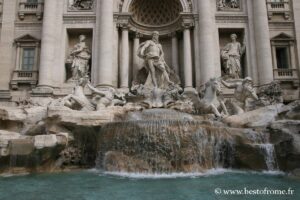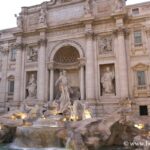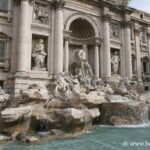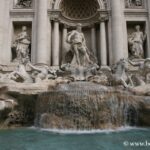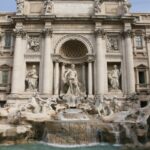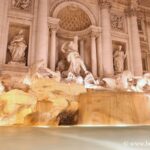The Trevi Fountain, an architectural gem of Rome and a star of Fellini‘s La Dolce Vita, is the city’s most iconic and visited fountain. Its Baroque design and rich history, dating back to the Acqua Vergine aqueduct, make it an unmissable symbol. According to popular tradition, tossing a coin into its basins ensures a return to Rome.
This page explores the monument’s history, describes its architecture and symbolism, and provides practical tips for visiting and finding the best nearby accommodations.
The visit to the Trevi Fountain ranks 8th in our Top 30 Things to See in Rome.
Description and Symbolism of the Trevi Fountain
The Trevi Fountain is backed by the Palazzo Poli, built between 1728 and 1730, and sits below street level due to the aqueduct’s altitude.
The sculptural ensemble illustrates the theme of the sea, symbolized by a large rectangular basin with rounded edges.
The composition is divided vertically: a rocky cliff occupies the lower part of the structure, while a wide central niche, framed by columns, dominates the whole. This niche houses an imposing statue of Ocean guiding a shell-shaped chariot, pulled by two winged sea horses led by tritons. On either side, two smaller niches contain statues of Health on the right and Abundance on the left, referencing the purity of the water.
The horses embody the changing states of the sea: the spirited, untamed horse on the left contrasts with the calm, controlled one on the right.
Above the side niches, bas-reliefs depict scenes tied to the aqueduct: on the left, Agrippa approving the construction of the Aqua Vergine; on the right, the legend of a young girl showing soldiers the spring’s location.
Atop the tall Corinthian columns, four allegorical statues represent, from left to right: the “Abundance of Fruits,” the “Fertility of the Fields,” the “Riches of Autumn,” and the “Arrangement of Gardens.” The fountain’s inaugural inscription sits between the central statues, crowned by Pope Clement XII’s coat of arms.
The travertine-carved cliff features water streams and decorative elements like plants and animals, crafted by various artists and artisans. Water gushes from multiple points before flowing into the main basin. The three basins beneath the chariot were added to the design by Giuseppe Pannini.
On the rock to the left of the fountain, a large travertine pot, unrelated to the overall theme, was sculpted. According to a popular anecdote, Salvi placed it there to block the view of a barber whose shop overlooked the fountain and who constantly criticized his work.
Suggested Visit to the Fountain
Selection of Accommodations Near the Trevi Fountain
Selection of hotels, apartments, and rooms near the Trevi Fountain, sorted by price and distance:
- Good hotels and accommodations sorted BY PRICE within 600 meters of the Trevi Fountain
- Good hotels and accommodations sorted BY DISTANCE from the fountain
Useful Information for Exploring the Fountain and Map
Online Resources
- Info on the 060608 municipal site
- Trevi Fountain on Wikipedia
- On Rome-Roma: description and history of the fountain
How to Reach the Trevi Fountain and Map
Located on Piazza di Trevi, the square is accessible on foot from central Rome. The nearest metro station is Barberini (Line A), less than a 10-minute walk away. Buses also stop nearby, particularly on Via del Tritone or Via del Corso.
Fontana di Trevi, Piazza di Trevi
If you see this after your page is loaded completely, leafletJS files are missing.
Curiosities About the Trevi Fountain
A Fortune in Coins Underwater
Each year, approximately 1.5 million euros in coins are tossed into the Trevi Fountain by visitors hoping to return to Rome, per tradition. These funds are donated to the charity Caritas, which supports the underprivileged. It is forbidden, under penalty of a fine, to retrieve a coin from the basin.
The Travertine Pot: A Tale of Revenge
On the left side of the fountain, a large travertine pot seems out of place. Legend has it that architect Nicola Salvi added it to obstruct the view of a barber who endlessly criticized his work.
An Uncertain Origin of the Name
Several theories explain the fountain’s name: “Tre Vie” meaning three ways, may refer to the three streets converging at the square, or “Trivia” a Roman deity linked to crossroads.
Trevi Fountain Photo Gallery
- Trevi Fountain
- Trevi Fountain
- Ocean in the center
- Trevi Fountain
- Trevi Fountain
- Trevi Fountain by night
- Trevi Fountain in the evening
FAQ and Tips About the Trevi Fountain
Why Do People Throw a Coin into the Trevi Fountain?
Tradition holds that throwing a coin over your right shoulder, with your back to the fountain, ensures a return to Rome. A second coin grants a wish, and a third promises love.
When to See the Trevi Fountain Without Crowds?
The Trevi Fountain is almost always crowded during the day. However, early mornings (6 AM–8 AM) or late evenings (after 10 PM) offer fewer people and a pleasant nighttime ambiance. Note that the fountain is cleaned on certain days.
What to See Near the Trevi Fountain?
- About a 5-minute walk away, the Quirinal Square and Palace
- Via del Corso, a popular shopping street nearby









